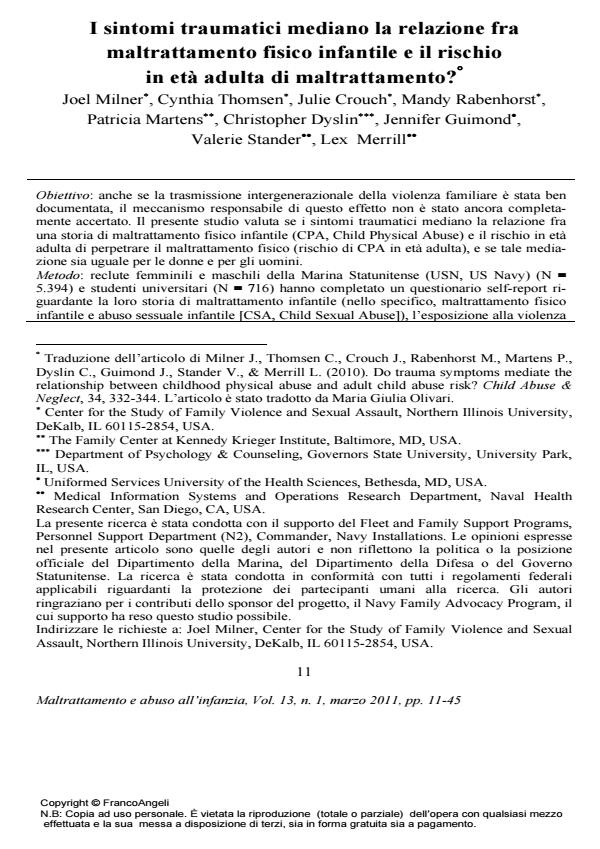Do trauma symptoms mediate the relationship between childhood physical abuse and adult child abuse risk?
Journal title MALTRATTAMENTO E ABUSO ALL’INFANZIA
Author/s Joel Milner, Cynthia Thomsen, Julie Crouch, Mandy Rabenhorst, Patricia Martens, Christopher Dyslin, Jennifer Guimond, Valerie Stander, Lex Merrill
Publishing Year 2011 Issue 2011/1
Language Italian Pages 35 P. 11-45 File size 500 KB
DOI 10.3280/MAL2011-001002
DOI is like a bar code for intellectual property: to have more infomation
click here
Below, you can see the article first page
If you want to buy this article in PDF format, you can do it, following the instructions to buy download credits

FrancoAngeli is member of Publishers International Linking Association, Inc (PILA), a not-for-profit association which run the CrossRef service enabling links to and from online scholarly content.
Objective: although the intergenerational transmission of family violence has been well documented, the mechanisms responsible for this effect have not been fully determined. The present study examined whether trauma symptoms mediate the relationship between a childhood history of child physical abuse (CPA) and adult CPA risk, and whether any such mediation was similar for women and men. Method: female and male US Navy (USN) recruits (N = 5,394) and college students (N = 716) completed self-report measures of their history of child abuse (i.e., CPA and child sexual abuse [CSA]), exposure to intimate partner violence (IPV), current trauma symptoms, and adult CPA risk. Results: as expected, there was a strong association between a childhood history of CPA and adult CPA risk. This association was significant even after controlling for demographic variables and childhood exposure to other forms of violence (CSA and IPV), and the strength of the relationship did not vary depending on demographics or exposure to other forms of violence. However, the association between a history of CPA and adult risk of CPA was stronger for individuals high in defensive avoidance compared to those low in defensive avoidance. The association between a history of CPA and adult CPA risk was largely, although not entirely, mediated by psychological trauma symptoms. Mediation was observed for both women and men in both the USN and college samples. Conclusions: trauma symptoms associated with a history of CPA accounted for a substantial part of the relationship between a history of CPA and adult CPA risk in both women and men. Practice implications: to the extent that trauma symptoms are a mechanism by which the intergenerational transmission of child abuse occurs, intervening to reduce trauma symptoms in CPA victims has the potential of reducing their risk of continuing the cycle of violence.
Keywords: Childhood physical abuse, trauma symptoms, trauma mediation, adult child abuse risk
Joel Milner, Cynthia Thomsen, Julie Crouch, Mandy Rabenhorst, Patricia Martens, Christopher Dyslin, Jennifer Guimond, Valerie Stander, Lex Merrill, I sintomi traumatici mediano la relazione fra maltrattamento fisico infantile e il rischio in età adulta di maltrattamento? in "MALTRATTAMENTO E ABUSO ALL’INFANZIA" 1/2011, pp 11-45, DOI: 10.3280/MAL2011-001002